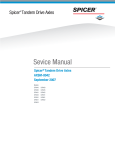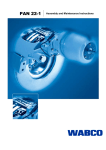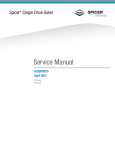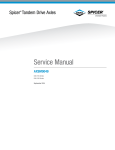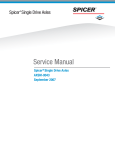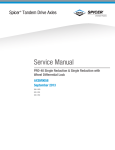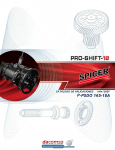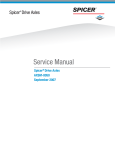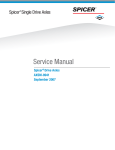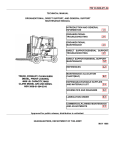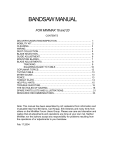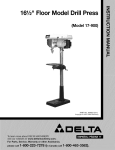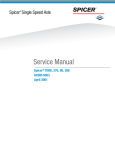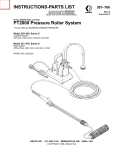Download Spicer Drive Steer Axles Service Manual
Transcript
Spicer Drive Steer Axles ® Service Manual Spicer® Drive Steer Axles AXSM-0051 September 2007 The description and specifications contained in this service publication are current at the time of printing. Dana Corporation reserves the right to discontinue or modify its models and/or procedures and to change specifications at any time without notice. Any reference to brand name in this publication is made as an example of the types of tools and materials recommended for use and should not be considered an endorsement. Equivalents may be used. IMPORTANT NOTICE This symbol is used throughout this manual to call attention to procedures where carelessness or failure to follow specific instructions may result in personal injury and/or component damage. Departure from the instructions, choice of tools, materials and recommended parts mentioned in this publication may jeopardize the personal safety of the service technician or vehicle operator. WARNINGS: FAILURE TO FOLLOW INDICATED PROCEDURES CREATES A HIGH RISK OF PERSONAL INJURY TO THE SERVICING TECHNICIAN. Caution: Failure to follow indicated procedures may cause component damage or malfunction. Note: Additional service information not covered in the service procedures. Tip: Helpful removal and installation procedures to aid in the service of this unit. Always use genuine Spicer replacement parts. 2 Drive Steer Axle Wheel End Contents Important Notice ....................................................... 2 Introduction ............................................................. 4 Steer Axle Identitication .............................................. 4 Wheel End Identification ............................................. 5 Lubrication ............................................................. 5 Cleaning, Inspection, Repair and Replacement .................. 7 General Inspection .................................................... 8 Wheel Alignment and Wheel End Inspection ...................... 9 Wheel End Removal ................................................. 11 Hub and Drum Assemblies 16K, 18K and 21K Hub and Drum Explode ........................ 12 16K, 18K and 21K Hub and Drum Parts List ...................... 12 23K Hub and Drum Explode ......................................... 13 23K Hub and Drum Parts List ....................................... 13 Hub and Drum Removal ............................................. 14 Hub and Drum Reassembly ......................................... 16 Model EDS16S, EDS18S, EDS21S Axle End Kit 21K Explode (16K and 18K Similar) ................ 18 Axle End Kit 21K Parts List (16K and 18K Similar) .............. 19 Front Axle Disassembly ............................................. 20 Inspection .............................................................. 21 Front Axle Assembly ................................................. 22 Model EDS23S Axle End 23K Kit Explode ............................................ 26 Axle End Kit 23K Parts List .......................................... 27 Drive Steer Axle Wheel End Disassembly ........................ 28 Inspection and Repair ............................................... 32 Drive Steer Axle Wheel End Assembly ............................ 33 Fastener Torques ..................................................... 39 3 Drive Steer Axle Wheel End Introduction Steer Axle Identification This manual includes instructions for the following Spicer Drive Axles; The complete axle is identified by the specification number stamped on a metal tag attached to the rear right-hand side of the axle housing. This number identifies all component parts of the axle as built by Spicer, including special OEM requirements such as yoke or flange. • • • • EDS16S EDS18S EDS21S EDS23S Description and Operation The front axle is a driving, full-floating axle. Garden type universal joints enclosed in a hollow ball at the end of the axle housing provide driving power and maintain steering control. The jointed end of the axle shaft passes through a skein, a hollow spindle with mounted wheel bearings. The skein attaches to a ball socket, a one-piece housing surrounding the axle ball. The axle housing is one piece. A ball and socket assembly and wheel end equipment are attached to each end of the housing. For service information on differentials, refer to separate service manuals listed on the back cover of this manual. EDS - 18S Axle Gearing Types* *S-Single Reduction *Single Reduction with Controlled Traction Differential *T-dual Range *P-double Reduction Axle Capacity (X 1000) 18,000 Ibs. Drive Steer Spicer This information applies only to the axle housing and should be used when servicing the housing. PT. NO. − Part number for axle housing only HSG. CAP − GAWR for axle housing − Identification number for axle housing only HSG. I.D. No.− HOUSING MADE IN − Indentifies manufacturing location of axle housing 4 Drive Steer Axle Wheel End Wheel End Identification Lubrication The tag attached to the wheel end identifies the wheel end assembly. To assure quiet, trouble-free operation over a period of years, use approved gear lubricant in correct quantities. The following lubrication instructions represent the most current recommendations from the Dana Corporation, Axle & Brake Division. Do not use separate oil additives and/or friction modifiers in Spicer Drive Axles. Approved Lubricating Approved Lubricants-General: Gear lubricants acceptable under military specification (MILSPEC) MIL-L-2105D (Lubricating Oils, Gear, Multipurpose) are approved for use in Spicer Drive Axles. The MIL-L-2105D specification defines performance and viscosity requirements for multigrade oils. It supersedes both MIL-L-2105B, MIL-L-2105C and cold weather specification MIL-L-10324A. This specification applies to both petroleum-based and synthetic-based gear lubricants if they appear on the most current “Qualified Products List” (QPL-2105) for MIL-L-2105D. Approved Lubricants-Synthetic Based: Synthetic-based gear lubricants exhibit superior thermal and oxidation stability, and degrade at a lower rate when compared to petroleum-based lubricants. The performance characteristics of these lubricants include: extended change intervals, improved fuel economy, better extreme temperature operation, reduced wear and cleaner component appearance. Spicer gear lubricants are premium quality synthetic lubes which fully meet or exceed the requirements of MIL-L-2105D. These products, available in both 75W-90 and 80W-140, provide superior performance in comparison to others qualified under the MILSPEG, as demonstrated by extensive laboratory and field testing. Lube Sampling and Condition Monitoring: For information, contact your local Spicer representation, listed on the back cover of this manual. Makeup Lube: Maximum amount of non-synthetic makeup lube is 10%. 5 Drive Steer Axle Wheel End Viscosity/Ambient Temperature Recommendations: The following chart lists the various SAE Grades covered by MIL2105D and the associated ambient temperature range for each. Those SAE Grades shown with an asterisk (*) are available in the Spicer family of synthetic gear lubricants. Grade 75W 75W-80 75W-90* 75W-140 80W-90 80W-140* 85W-140 Ambient Temperature Range -40°F to -15°F (-40°C to -26°C) -40°F to 80°F (-40°C to 27°C) -40°F to 100°F (-40°C to 38°C) -40°F and above (-40°C and above) -15°F to 100°F (-26°C to 38°C) -15°F and above (-26°C and above) 10°F and above (-12°C and above) When changing lubricant, Spicer recommends: • Changing the oil filter • Cleaning − magnetic filler plug − screen − drain plug − breather Changing Lube Draining Tip: Drain when the lube is at normal operating temperature. Lube will run freely and reduce drainage time. The lowest ambient temperatures covered by this chart are -40 F and -40 C. Lubrication recommendations for those applications which consistently operate below this temperature range, are available from Dana Corporation, Axle & Brake Division. To drain: Lube Change Intervals 3. Inspect drain plug for large quantities of metal particles. After initial oil change, metal particles indicate damage or extreme wear in the axle, and warrant inspection of the entire unit. Lubrication Change Intervals-General: The initial lubricant change improves axle component life and durability by removing break-in contaminants from the system. These contaminants are primarily metal from the initial break-in wear of rotating components, and silicon from the sand used in manufacture of cast components. For either a new or rebuilt drive axle, the lubricant should be changed within the first 3000 to 5000 miles of operation. Refer to the following chart for subsequent lubricant changes. Lube changes may vary from those recommended in this chart based on the application and operating environment. Lubrication Change Intervals-Severe Service: Severe service applications are those which require the axle to be consistently operated near maximum GCW or GVW ratings, dusty or wet environments, or consistent operation grades greater than 8%. For these applications, refer to the ON/OFF HIGHWAY portion of 1. Unscrew the magnetic drain plug on the underside of the axle housing. 2. Drain lube into a suitable container. 4. Clean and replace drain plug. Filling To add lube, remove the filler hole plug from the center of the axle housing cover. Fill the axle with approved lubricant until level with bottom of hole. Tip: Lube fill capacities may vary. Always use the filler hole as the final reference. Lube should be level with the bottom of the hole. Axles installed at angles exceeding 10° or operated regularly in areas of continuous and lengthy grades may require standpipes to allow proper fill levels. For specific recommendations, contact you local Spicer representative, listed on the back cover of this manual. Guidelines-Lube Change Intervals for Drive Axles Maximum Change Interval Maximum Change Interval On/Off Highway Severe Service Miles Maximum Change Interval Petroleum Based 100,000 Yearly 40,000 Yearly Synthetic Based 200,000 3 Years 80,000 Yearly Spicer™ Synthetic 250,000 3 Years 100,000 Yearly Lubricant Type 6 Drive Steer Axle Wheel End Cleaning, Inspection, Repair and Replacement As the wheel end is disassembled, set all parts aside for thorough cleaning and inspection. Careful inspection will help determine whether parts should be reused. In many cases, the causes of premature wear or failure will also be revealed. Cleaning Assembles may be steam cleaned while mounted to the housing as long as all openings are tightly plugged. Once removed, do not steam clean any components. Steam cleaning at this time could allow water to be trapped in passages, leading to rust, lubricant contamination, and premature component wear. The only proper way to clean the assembly is to disassemble it completely. Other methods will not be effective except as preparatory steps in the process. Wash steel parts with ground or polished surtaces in solvent. There are many suitable commercial solvents available. Kerosene and diesel fuel are acceptable. WARNING: GASOLINE IS NOT AN ACCEPTABLE SOLVENT BECAUSE OF ITS EXTREME COMBUSTIBILITY. IT IS UNSAFE IN THE WORK SHOP ENVIRONMENT. Wash castings or other rough parts in solvent or clean in hot solution tanks using mild alkali solutions. If a hot solution tank is used, make sure parts are heated thoroughly, before rinsing. Rinse thoroughly to remove all traces of the cleaning solution. Dry parts immediately with clean rags. Lightly oil parts if they are to be reused immediately. Otherwise, coat with oil and wrap in corrosion-resistant paper. Store parts in a clean, dry place. Inspection Inspect steel parts for notches, visible steps or grooves created by wear. Look for pitting or cracking along gear contact lines. Scuffing, deformation or discoloration are signs of excessive heat in the axle, usually related to low lubricant levels or improper lubrication practices. Before reusing a gear set, inspect teeth for signs of excessive wear. Check tooth contact pattern for evidence of incorrect adjustment. Inspect fasteners for rounded heads, bends, cracks or damaged threads. Examine the axle housing for cracks or leaks. Also look for loose studs or cross-threaded holes. Inspect machined surfaces for nicks and burrs. Repair and Replacement Important: To achieve maximum value from an axle rebuild, replace lower-cost parts, such as thrust washers, seals, etc. These items protect the axle from premature wear or loss of lubricants. Replacing these parts will not increase rebuild cost significantly. It is also important to replace other parts which display signs of heavy wear even though not cracked or broken. A significant portion of such a part’s useful life has been expended and the damage caused, should the part fail, is far in excess of its cost. Important: LH & RH wheel ends are different. Be sure to identify parts and keep them separate. Steel Parts - Gear sets, input and output shafts, differential parts and bearings are not repairable. Worn or damaged parts should be discarded without hesitation. Also discard mating parts in some cases. Gear sets, for example, must be replaced in sets. Miscellaneous parts - Seals and washers are routinely replaced. None of these parts can be reused if damaged. Fasteners using selflocking nylon “patches” may be reused if not damaged, but should be secured by a few drops of Loctite #277 on the threaded surface of the hole during installation and carefully torqued during installation. Axle Housings - Repairs are limited to removal of nicks or burrs on machined surfaces and the replacement of loose or broken studs. Caution: Any damage which affects the alignment or structural integrity of the housing requires housing replacement. Repair by welding or straightening should not be attempted. This process can affect the housing heat treatment and cause it to fail completely when under load. Silicone Rubber Gasket Compound - For more effective sealing, Spicer uses silicone rubber gasket compound to seal the majority of metal-to-metal mating surfaces. Spicer includes gasket compound and application instructions in many repair parts kits. It is recommended that this compound be used in place of conventional gaskets. The compound will provide a more effective seal against lube seepage and is easier to remove from mating surfaces when replacing parts. Always use Spicer Genuine Axle Parts and Parts Kits Genuine Spicer replacement parts are the same high quality as the original components and include the latest engineering improvements. Parts kits have only one part number which makes ordering, stocking and servicing easier. They are not only convenient, but give the advantage of having every part needed for a good repair job. 7 Drive Steer Axle Wheel End General Inspection Wheels Wheel Alignment Routine check of: Proper wheel alignment promotes longer tire wear, provides ease of handling, and minimizes strain on front suspension and axle components. Caution: Do not check and adjust front wheel alignment without first making the following inspection for front end improper adjustment, damage or wear: 1. Check the air pressure in all the tires. Make sure that the pressures agree with those specified for the tires and vehicle model being checked. Wheel Stud Nuts Wheel stud nuts should be inspected and tightened twice in the first 500 miles, and again after 1,000 miles to avoid accidental loosening of the wheels. Loose wheel stud nuts can cause shimmy, vibration and elongated stud holes in the wheels. 2. Raise the front of the vehicle off the floor. Grasp each front tire at the front and rear, and push the wheel inward and outward. Adjust the wheel bearings if free play occurs between the brake drum and the brake backing plate. Wheel and Hub 3. Check brakes for dragging. Check for damage that would affect the runout of the wheels. 4. Check all steering linkage for wear or improper adjustment. Replace worn parts. Wheel Rim 5. Check the steering gear mounting bolts, and tighten to specification if required. Inspect the wheel rims for dents that could permit air to leak from the tires. 6. Check the front spring clips (U-bolts) and the spring tie bolt. Tighten if required. Tires 7. Spin each front wheel with a wheel spinner. Check and balance each wheel as required. 8. Rotate each front wheel slowly, and observe the amount of lateral or side runout. If the wheel runout exceeds 1/8′′, replace the wheel or install the wheel on the rear. Front Wheel Bearings Replace front wheel bearings when excessively worn or damaged. Check the bearing cups for proper installation before removing them for replacement. If a cup is improperly seated in the hub, inspect the hub for burrs, rough spots, or other irregular surfaces that would prevent seating the cup properly. Tip: Bearing damage is offen caused by lack of lubrication or improper adjustment. When installing bearing cups or cones and rollers, use the specified lubricant and adjust the bearings. Wobble or shimmy caused by a damaged wheel will eventually damage the wheel bearings. 8 • Wheel stud nuts • Wheel and hub • Wheel rim Keep the wheels and hubs clean. Stones or lumps of mud wedged between the wheel and drum will unbalance a wheel and tire. 1. Check tires frequently to be sure that the air pressures agree with those specified for the tires and vehicle model. 2. Inspect the tire treads and remove all stones, nails, glass, or other objects that may be wedged in the tread. Check for holes or cuts that may permit air leakage from the tire. Make the necessary repairs. 3. Inspect the tire side walls for cuts, bruises, and other damage. If internal damage is suspected, demount the tire from the wheel for further inspection and repair. 4. Check the valve for air leaks. Replace the valve if necessary. Replace any missing valve caps. Drive Steer Axle Wheel End Wheel Alignment and Wheel End Inspection Caster Angle Tie Rod and Tie Rod Ends Caster angle is the degrees the top of the kingpin inclines toward the front or rear of the vehicle. (See Figure 2). Caster angle is viewed from the side of the vehicle. The caster angle ranges from a positive to a negative angle. Tie rods consist of: • • Tie rod Two rod end assemblies The ends are threaded to the rod and locked with clamp bolts. Right and leff hand threads provide for toe-in adjustment. Ball stud tension in the tie rod ends self-adjusts. Periodically inspect to see that the ball studs sit tight in the steering knuckle arms. Fittings allow lubrication of some tie rod ends. Where no fittings are used, the tie rods have been lubricated at assembly and do not require further lubrication. Wheel End Alignment Factors To check wheel alignment, or when installing new axle parts, check the following on both wheels: A positive caster indicates that the top of the kingpin tilts toward the rear of the truck and imparts a trailing action to the front of the wheels. Negative, or reverse caster, tilts toward the front of the truck and causes a leading action. The correct amount of caster helps to keep the wheels in the straight-ahead position. When turning a curve, caster acts as a lever to return the wheels to the straight-ahead position. Caster specifications are set in all new vehicles. However, variations in spring equipment, type of service, tire, wheel size or wheel base may make a slight change in caster angle desirable to provide the best possible steering stability. The caster angle must be equal at both wheels. 1. Camber Angle 2. Caster 3. Toe-in Camber Angle Unequal camber in the front wheels causes the truck to lead to the right or leff. The truck will lead to the side which has the most positive camber. Normal camber angle is 1/2 degree. Camber is nonadjustable. Damage will change the angle of the axle ball assembly or axle housing. Figure 2 Caster Angle Figure 1 Chamber Angle 9 Drive Steer Axle Wheel End Toe-in Adjustment with Tires On Toe-in is set at 0′′ to 1/8′′. The front and the rear of the wheels should be the same distance apart or the front should be 1/8′′ closer than the rear. Change adjustment by turning tie rod to change its length. Adjustment can be checked as follows (See Figures 3 and 4): 1. Scribe a line at center of each tire tread completely around the tire by rotating wheel while holding chalk against tire tread. Line must begin and end at the same point. (See Figure 3). Toe-In Adjustment with Tires Off 1. With tires off, place two straight edges approximately 50′′ long against wheel mounting surfaces. 2. Measure between or over the straight edges. The dimensions at the front side of the axle should be equal to or 1/8′′ less than the dimensions measured at the rear side of the axle. 3. Adjust as necessary. 2. Measure the line on the axle centerline at front of the tires. (See Figure 4). 3. Repeat measurement at rear of tires. 4. Compare measurements. Front measurement (A) should be the same or 1/8′′ shorter than rear measurement (B). 5. Adjust tie rod as required. Figure 4 Measure Toe-in Figure 3 Scribe Tires 10 Drive Steer Axle Wheel End Wheel End Removal Tip: This procedure is used only when servicing the carrier assembly. Both left-hand and right-hand wheel ends are removed the same way, except where otherwise specified. Face the differential carrier side of the axle to differentiate between left-hand and right-hand. WARNING: DO NOT LIE UNDER CARRIER AFTER FASTENERS ARE REMOVED. USE TRANSMISSION JACK TO SUPPORT AND REMOVE DIFFERENTIAL CARRIER ASSEMBLY. To remove wheel end: 1. Drain axle lube. 2. Separate wheel end assembly from axle housing by removing capscrews and nuts fastening socket ball to the housing. 3. Disconnect air brake lines and steering connections as required to permit moving the wheel end assembly outwards until the axle shaft disengages from the differential side gear. Disengage axle shaft on both sides of axle. Figure 5 Remove Wheel End Assembly from housing 11 Hub and Drum Assemblies Hub and Drum Assemblies Figure 1 16K, 18K and 21K Hub and Drum Assembly 16K, 18K and 21K Hub and Drum Assembly Parts List ITEM NO. DESCRIPTION ITEM NO. DESCRIPTION 39. 47. 48. 51. 52. 53. 54. 55. Skein, Front Axle Drum, Brake Stud, Mounting Seal, Hub Oil Spacer, Oil Seal Cone, Hub Bearing Cup, Hub Bearing Hub, Front 56. 57. 58. 59. 60. 61 62. Capscrews, Bearing Nut Nut, Wheel Assembly Gap Assy Capscrew Capscrew Lock, Bearing Nut Lockwasher 12 Hub and Drum Assemblies Figure 2 23K Hub and Drum Assembly 23K Hub and Drum Assembly Parts List ITEM NO. DESCRIPTION ITEM NO. DESCRIPTION 33. 39. 40. 41. 42. 43. 44. 45. 46. Skein, Front Axle Seal, Hub Oil Spacer, Oil Seal Cone, Hub Bearing Cup, Hub Bearing Hub, Front Drum, Brake Capscrew Capscrew 47. 48. 49. 50. 51. 52. 53. 54. 55. Lockwasner Capscrew Cap Assy Nut, Wheel Bearing Capscrew, Bearing Nut Lockwasher Lock, Bearing Nut Tack Plate, ID 13 Hub and Drum Assemblies Hub and Drum Removal To disassemble: 1. Remove attaching stud nuts and Iockwashers. 2. Remove the hubcap with puller screws in the holes. (See Figure 3). Note: Capscrews in the puller holes during vehicle operation will protect the threads. 3. Remove bearing nut lock, lockwasher and bearing nut capscrews. (See Figure 4). 4. Remove wheel bearing nut. (See Figure 5). 5. Pull the outer cone away from the axle and remove the outer wheel bearing cone. (See Figure 6). Caution: If reusing the cones, keep matched sets and reinstall in original location. 6. Drive out the oil seal (39) and the wheel bearing spacer (40). 7. Lift out the inner wheel bearing cone. (See Figure 7). Caution: Never remove the cups in the hubs unless replacing them due to pitting, scoring or other damage. Insert a driver into the hub grooves to remove cups. Figure 3 Removing Hupcap 14 Figure 4 Removing Bearing Nut Lock Figure 5 Removing Wheel Bearing Nut Hub and Drum Assemblies Figure 6 Removing Hub Bearing Cone Figure 7 Removing Inner Bearing 15 Hub and Drum Assemblies Hub and Drum Reassembly 1. If replacing wheel bearings, press the outer and inner wheel bearing cups into the hub. Install the cups with the race facing outwards. Be sure the cups are fully seated on the shoulder of the hub bore. 2. Line the entire inner wall of the hub with grease. Pack inner wheel bearing cone. 3. Place the inner wheel bearing cone into the inner bearing cup. Install bearing spacer on top of bearing cone. (See Figure 8). 4. Position wheel bearing oil seal so that the lip faces inwards. Tap the seal flush with the edge of the hub face. (See Figure 9). Coat the lip of the seal with grease and make sure the seal spring is in position. Caution: There will be slack between the cone, spacer and seal. This will be taken up when the wheel bearing lock nut is adjusted. Do not force the seal to take up the slack. 5. Grease the axle skein lightly. Slide hub and drum assembly over the skein and brake assembly. Make sure the assembly is on the skein as far as possible. Figure 9 Installing Oil Seal 6. Pack the outer wheel bearing cone. Slide outer wheel bearing cone into the outer wheel bearing cup in the hub. 7. Turn the wheel bearing nut onto the skein until it is tight against the outer wheel bearing cone. Torque nut to about 100 lb. ft. (136 N•m) to seat bearings. Back off to the closest slot. Figure 10 Installing Wheel Bearing Nut Figure 8 Installing Inner Bearing 16 Hub and Drum Assemblies 8. Measure the hub (43) rotating drag by pulling at the wheel studs. Proper drag is 4-10 pounds to keep (not start) the hub turning. Adjust wheel bearing nut (50) as required to set proper drag. 9. Install the bearing lock into the slot in the lock nut that lines up with a slot in the axle skein (33). Install capscrew and lockwasher to secure bearing lock in place. Torque capscrew to 25 lb. ft. (34 N•m) wet. 10. Pack the groove inside the hubcap with a layer of grease about 1/2′′ thick. Use a soft hammer to drive the hubcap onto the studs. 11. Install lockwashers and nuts on the hub assembly. Torque nuts to 130 lb. ft. (176 N•m) wet. 12. Install capscrews in hubcap puller screw holes to protect threads. 13. Connect air brake line at air chamber (36). 14. Adjust brake shoes. 15. Connect steering drag link and tie rod. 16. Install coffer pins in drag link. Figure 12 Tightening Lock Nut Figure 11 Measuring Hub Rotating Drag Figure 13 Installing Hupcap 17 16K, 18K and 21K Drive Steer AxleWheel End Model EDS16S, EDS18S, EDS21S Figure 1 Axle End Kit 21K (16K and 18K similar) 18 16K, 18K and 21 K Drive Steer Axle Wheel End Axle End Kit 16K-21K Parts List ITEM NO. 1. 2. 3. 4. 5. 6. 7. 8. 9. 10. 11. 12. 13. 14. 15. 16. 17. 18. 19. 20. 21. 22. 23. 24. 25. 26. 27. 28. 29. 30. 31. 32. DESCRIPTION Seal, Housing Oil Ball, Axle Capscrew Plate, End Trunnion Retainer, Seal Seal, Socket Stud Steering Arm Nut,Hex Lockwasher Dowel Fitting End, Tie Rod, RH Bearing,Top Ball Socket Seal, Oil Tie Rod End, Tie Rod, LH Shaft, Inner Axle Cage Ring Assembly Shaft, Outer Axle Bolt Plug, Pipe Lockwasher Cover, Bottom Shim Bearing, Bottom Nut, Hex Screw, Stop Lockwasher Capscrew ITEM NO. 33. 34. 35. 36. 37. 38. 39. 40. 41. 42. 43. 44. 45. 46. 47. 48. 49. 50. 51. 52. 53. 54. 55. 56. 57. 58. 59. 60. 61. 62. 63. 64. DESCRIPTION Bushing Pin, Spring Brake Spider & Pin Assy Yoke Brake Chamber Anchor, Control Arm Skein, Front Axle Slack Adjuster Spacer Bracket Assy, Chamber Mounting Fitting Capscrew Lockwasher Brake Kit Drum, Brake Stud, Mounting Capscrew Washer, Plain SeaI,Hub Oil Spacer, Oil Seal Cone, Hub Bearing Cup, Hub Bearing Hub, Front Capscrew, Bearing Nut Nut, Wheel Bearing Cap Assy Capscrew Capscrew Lock, Bearing Nut Lockwasher Tack Plate, ID 19 16K, 18K and 21K Drive Steer Axle Wheel End Front Axle Disassembly Axle Shaft, Hub, Bearing and Seal Removal WARNING: PARK VEHICLE ON LEVEL GROUND AND SUPPORT FRONT AXLE ON JACK STANDS TO PREVENT INJURY. The right and left axle parts are similar. When it is necessary to remove the axle, ball and socket, remove as an assembly. The following procedures will work for either side. To repair front axle: 1. Drain axle lubricant. 2. Remove (Refer to Hub & Drum Removal, page 15): • • • • • Tire Wheel Brake drum Camshaft Brake shoes 3. Remove ten bolts (60) and two bolts (59) from cap (58). 4. Attach a slide hammer to cap (58) where two bolts (59) were removed. 5. Remove cap (58) from hub (55) with slide hammer. 6. Remove the following from bearing nut (57) : • Bolt (56) • Lockwasher(62) • Bearing nut lock (61) Figure 2 Match Marking Axle Shaft 20 7. Remove bearing nut (57) from skein (39) using wheel bearing wrench. 8. Remove outer bearing cone (53) from hub (55). If reusing bearing cone, keep in matched sets and tag for proper reassembly. 9. Remove hub (55) from skein (39). 10. Using drift, drive seal (51) and spacer (52) from hub (55). 11. Remove inner bearing cone (53) from hub (55). 12. If bearing cups (54) are worn or damaged, use a drift to drive both bearing cups from hub (55). 13. Mark spider and ball socket for proper reassembly. Remove ten bolts (49) and washers (50) from skein. Remove skein (39) and spider (35) from ball socket (16). 14. Turn ball socket to straight ahead position. Garefully pull axle shaft and cage ring assembly from axle. 15. Mark cage ring halves and both axle shafts using a punch. (See Figure 2). 16. Remove eight bolts using an allen head wrench. (See Figure 3). 17. Separate shafts (20 and 22) by removing cage ring halves (21). Remove pin, if damaged. Tip: If replacing ball socket or related parts, continue with Ball and Socket Removal procedure (page 21). If not, clean all parts, then go to Inspection procedure (page 21). Figure 3 Separating Cage Rings 16K, 18K and 21K Drive Steer Axle Wheel End Ball and Socket Removal To remove ball and socket: Tip: Mark all ball socket parts before removal. 1. Mark location of clevis and remove from slack aduster (40). 2. Remove brake chamber bracket (42) from ball socket (16). Leave air line connected to chamber (37). Hang chamber and bracket out of the way. Do not hang by air line. 3. Remove slack adjuster (40) and camshaft. 4. Disconnect tie rod (18) from ball socket (16) by removing: • Gotter pin • Nut • Washer 5. Separate tie rod end (19) from ball socket (16). 6. When working on the left side, disconnect steering linkage by removing cotter pin and nut and dislodging ball joint from steering arm (9). Inspection Axle Shaft and Cage Ring To check clearance between axle shafts and cage ring: 1. Measure axle shaft trunnions. (See Figure 4). 2. Assemble cage ring halves and measure bore. (See Figur 4). 3. If the difference between these two measurements exceeds .050′′, replace parts. Bushing If axle ball (2) was replaced, inspect the bushing (33) as follows: 1. Measure machined surface of inner axle shaft with a micrometer. Shaft must measure a minimum of 2.50′′. 2. Measure inner diameter of bushing (33). 3. If the difference between the two measurements exceeds 0.015′′, replace worn parts. Carefully inspect all other parts for damage or wear. 7. Remove steering stop screw (30) and nut (29). 8. Remove bolts (32) and lockwashers (31). . 9. Carefully pry out seal retainers (6) and oil seal (7). 10. Remove top cover (4) and bottom cover (26) by removing bolts (23) and washers (25). To remove upper cover on lefthand ball socket: spread and remove dowels on the steering arm by inserting a screwdriver in the split and lifting upwards. Record number and thickness of shims (27) used under bottom covers (26). 11. Remove bolts (3) and end plates (4) from top and bottom. Use a drift to drive out trunnions(5). 12. Keeping both bearing cones (15 and 28) seated in their cups, carefully drive ball socket (16) down. This forces upper bearing cup out of its bore. Force bearing cup up at least 1/8′′. Drive ball socket up to force bottom cup out at least 1/8′′. 13. Tip ball socket (16) away and remove it from axle ball (2) while holding upper bearing cone in its cup. 14. Remove bearing cones (15 and 28). Drive out bearing cups. Tip: If bearings will be reused, label as top or bottom and keep separate. 15. Remove: • Bolts • Lockwashers • Axle ball (2) from axle housing • Housing oil seal (1) Figure 4 Check Axle Trunnion Wear 21 16K, 18K and 21K Drive Steer Axle Wheel End Front Axle Assembly Bushing Caution: All bearings and oil seals must be lubricated during assembly. Use grease to coat thoroughly. If bushing (33) was removed, install as follows: 1. Place bushing with beveled end facing into axle ball. 2. Firmly seat bushing using a press. 3. Ream bushing as required to provide a 0.003 to 0.005′′ clearance with axle shaft. Ball and Socket Installation 1. Install: • Oil seal (1) with lip facing up, away from axle baIl (2) • Oil seal retainers (6) • Oil seal (7) over axle housing end 2. Goat mating surfaces of the axle housing and ball socket (16) with sealant. 22 3. Attach axle baIl (2) to axle housing, in a vertical position, secure with large and small bolts and large and small Iockwashers. • Torque small bolts to 187 lb. ft. (253• N.m) • Torque large bolts to 400 lb. ft. (542•N.m) 4. Tip ball socket (16) and install over baIl (2). 5. Install top and bottom trunnions (5). Use a spreading fixture to hold in place. 6. Install bearing cones (15 and 28) and seat firmly on trunnions (5). 7. Install bearing cups (15 and 28) and seat firmly on cone. 8. Install bottom cover (26) with same shim pack (27) that was removed unless ball socket (16), axle ball (2), or any trunnion bearings were replaced. If any of these parts were replaced, install a new shim pack of .045′′. Tip: Shims are used to preload the trunnion bearings and to center the axle socket. No shims are used under upper trunnion cover or steering arm. 16K, 18K and 21K Drive Steer Axle Wheel End 9. Install bottom cover (26) and top shims (27) with: • Lockwashers (25) • Bolts (23) 10. Install upper cover or, if working on left side, steering arm with: • • • • Stud (8) Dowel (12) Lockwashers(11) Nuts(10) Note: Make sure steering arm is installed with finished surface toward bearing. 11. Torque lower cover bolts to 187 lb. ft. (253 N•m). Remove pipe plug (24) from lower cover and temporarily install a grease fitting. Tighten upper cover bolts to give ball socket a slight amount of drag. 12. Lubricate both trunnion bearings through upper and lower fittings with grease gun. Grease until it can be seen inside ball socket, coming through bearing cones. 13. Remove spreading fixture. Torque upper cover bolts or steering arm nuts to 320 lb. ft. (434 N•m). 15. Change shim pack (27) to correct bearing preload or to center axle socket. 16. Fill trough between back of ball socket and ball with grease. 17. Remove lower grease fitting and install pipe plug (24). 18. Push retainers (6) and seal (7) into ball socket. Tap retainer into place. 19. Coat capscrew (32) with Loctite and install with Iockwashers (31). Torque to 12 lb. ft. (16 N•m). 20. Install steering stop screw (30) with nut (29). Do not adjust at this point. 21. Turn ball socket against stop. Coat inside with grease. Turn socket the other way, and coat with grease. 22. Connect tie rod end to ball socket. Install washer and nut. Torque nut to 110-125 lb. ft. (136-169 N•m). Install new cotter pin. 23. Connect ball joint to steering arm (9). Torque nut to 110-125 lbs. ft. (136-169 N•m). Install new cotter pin if working on left side. 14. Use a spring scale to check bearing preload. To maintain ball socket movement requires a pull of about 38-42 lb. ft. (52-57 N•m). Ball socket must never contact or rub on axle ball at any position. 23 16K, 18K and 21K Drive Steer Axle Wheel End Axle Shaft, Hub, Bearing, and Seal Installation 1. Install appropriate cage ring half (21) over axle shaft (20 and 22). 2. Lightly coat cage ring bores and axle shaft trunnions with grease. 3. Align cage rings and shafts using punch marks made during disassembly. 4. Install and tighten eight bolts into cage rings. Axle shafts must move freely at least 30° on both sides of cage ring. 5. Torque bolts to 90 lb. ft. (122 N•m). 6. Turning ball socket straight ahead, grease axle shaft bushing in axle ball. 7. Pack inner walls of axle ball with 3/4′′ of grease, but leave axle shaft hole clear. 8. Remove all nicks or burrs from axle splines. Caution: Nicks or burrs will damage axle housing oil seal if not removed. 9. Install axle shaft (20) into ball socket (16). Caution: Be careful to not damage oil seal when installing axle into housing. 10. Completely cover cage rings (21) with excess grease. 11. Coat the following mating surfaces with sealant: • Ball socket (16) • Brake spider (35) • Skein (39) 12. Install spider (35) and skein (39) in same position as disassembly using ten bolts (49) and plain washers (50). Torque bolts (49) to 187 lb. ft. (253 N•m). 13. Install two bushings for the camshaft in ball socket (16). (See Figure 5). 14. Install seal on slack adjuster side so the spring side faces the slack adjuster. Install seal on brake assembly side so it faces away from the brake assembly. WARNING: PROPER SEAL INSTALLATION ALLOWS GREASE TO ESCAPE DURING PRESSURE BUILD-UP AND PREVENTS GREASE FROM ENTERING THE BRAKE ASSEMBLY. GREASE IN THE BRAKE ASSEMBLY COULD BE A SAFETY HAZARD. 15. Install shoes and camshaft. 16. Use a driver to install bearing cups (54) into hub (55) until firmly seated. 17. Fill hub (55) with grease. Leave a hole large enough for skein (39) to slide in. Coat seal and bearing surfaces of skein (39) with a thin film of grease. 18. Use bearing packing tool to pack bearing cones (53) with grease. 19. Install inner bearing (53) into rear of hub (55). 20. Install spacer (52) into hub (55) with inner bevel facing outwards. 21. Install seal (51) into hub (55) using a driver. Press flush with edge of hub and lip facing inwards. 22. Coat lip of seal (51) with grease. 23. Install hub (55) and drum (47) onto skein (39). 24. Install outer bearing (53) onto skein (39) and push into hub (55). 25. Screw bearing nut (57) on skein (39), finger tight. Caution: Torque nut (57) just enough to eliminate end play in hub. Overtightening will cause excessive drag and parts damage. 26. Eliminate end play by rotating hub (55) while tightening nut (57) with wrench. Figure 5 Camshaft Bushing Installation 24 16K, 18K and 21K Drive Steer Axle Wheel End 27. Back off nut to align slot in nut with nearest groove in skein (39). If nut (57) tightens halfway between slots in skein (39), remove and turn it over to obtain proper alignment. 28. Use wrench to install: • Lock plate (61) into slot in nut (57) • Lockwasher (62) • Bolt (56) and tighten bolt securely 29. Pack groove of hubcap (58) with grease and coat mating surface of cap with Loctite. 30. Install hubcap on hub (55) with ten bolts (60). 31. Torque bolts (60) to 187 lb. ft. (253 N•m). 32. Install two bolts (59) in hubcap (58). Torque bolts (59) to 55 lb. ft. (75 N•m). 33. Adjust toe-in if ball sockets or trunnion bearings were removed or if original adjustments were changed. This truck requires 0-1/8′′ toe-in. (See Toe-in Adjustment on page 11). 34. Adjust steering stops if ball sockets or trunnion bearings were removed or if original adjustments were changed. Adjust stop bolt to 27°. Measure at steering arm. (See Figure 6). Figure 6 Steering Stop Adjustment Left-Hand Turn To adjust: • • • • Turn wheels for a 27° turn, measured at steering arm. Turn stop screw on ball socket out to contact axle. Lock in place with lock nut. Repeat for other side. 35. Install tire and wheel. Check steering for proper operation. 25 23K Drive Steer Axle Wheel End Model EDS23S Figure 1 Axle End Kit 23K 26 23K Drive Steer Axle Wheel End Axle End Kit 23K Parts List ITEM NO. 1. 2. 3. 4. 5. 6. 7. 3. 9. 10. 11. 12. 13. 14. 15. 16. 17. 18. 19. 20. 21. 22. 23. 24. 25. 26. 27. 28. DESCRIPTION Seal, Oil Ball, Axle Capscrew Plate Trunnion Seal Plate Seal Stud Steering Arm Nut, Hex Lockwasher Dowel Fitting, Lube Tie Rod End, RH Bearing Socket, Ball Tie Rod Tie Rod End, LH Shaft, Axle Cage, Ring Shaft, Ball Plug Nut, Hex Lockwasher Stud Tie Rod Arm Shim Nut, Hex ITEM NO. 29. 30. 31. 32. 33. 34. 35. 36. 37. 38. 39. 40. 41. 42. 43. 44. 45. 46. 47. 48. 49. 50. 51. 52. 53. 54. 55. DESCRIPTION Screw Lockwasher Capscrew Bushing Skein, Front Axle Washer Capscrew Chamber, Air Brake Nut, Collet Brake Assy Seal, Oil Spacer Bearing Cone Bearing Cup Hub, Front Drum, Brake Wheel Stud, Metric Capscrew Lockwasher Capscrew Cap Assy Nut, Wheel Bearing Capscrew Lockwasher Nut Tack Plate, ID 27 23K Drive Steer Axle Wheel End Drive Steer Axle Wheel End Disassembly 1. Take off shoe retainer hardware and retractor springs to remove both brake shoes. (Refer to Hub & Drum Removal, page 15). 2. Loosen collet nut (37) on brake air chamber (36) and unscrew entire assembly from brake anchor (38). 3. Remove: • • • • 28 Nuts Lockwashers Two capscrews Brake shoe return spring bracket 4. Pull brake anchor assembly (38) away from the ball socket (16) and remove. 5. Use a soft hammer to loosen the axle skein (33) from ball socket (16). Caution: Use care when tapping on the skein (33) to not strike threads. 6. Place a pan under ball socket (16) to catch grease. Remove skein (33) by pulling it away from the ball socket (16). Figure 2 Removing Brake Shoes Figure 4 Brake Removal Figure 3 Removing Skein Nuts Figure 5 Loosening Skein 23K Drive Steer Axle Wheel End 7. Position ball socket (16) straight ahead. 8. Pull on the ball shaft to remove the axle shaft (20 and 22) and cage ring assembly (21). Tip: Mark the ball sockets and parts, as you remove them. Keep them separated so you can return them to their original positions. 9. Remove the ball seal capscrews and carefully pry out the seal (7). (See Figure 8). 10. Remove: • Tie rod arm (17) from boffom of ball socket (16) • Steering arm (9) or booster arm from top of ball socket (16) • Dowels (12) Figure 6 Removing Skein Figure 8 Removing Seal Plate and Seal Figure 7 Removing Axle Shafts and Cage Ring Figure 9 Removing Cover and Shims 29 23K Drive Steer Axle Wheel End 11. Insert a screwdriver into the slot in the dowel, spread and lift out the dowel. Take note of the quantity and thickness of the shims removed from the top and bottom trunnions. (See Figure 14). Tip: Some of the axle models do not require shims on the top trunnion. 12. Remove capscrews (3) and bearing retainer plate (4) from upper and lower ball trunnions (5). 14. Keeping the trunnion bearing cones (15) fully seated, drive the axle ball socket (16) down so the upper trunnion bearing cup (15) moves up and out of the ball socket at least 1/8′′ above the trunnion bearing cover parting surface. Repeat for lower trunnion bearing. (See Figure 11). 15. Holding the upper trunnion bearing cone upward, tip the ball socket housing and maneuver the bearing cone from the axle ball. (See Figure 12). 13. Using a suitable drift, drive trunnions out of the ball socket. (See Figure 10). Figure 10 Driving Out Trunnions Figure 11 Unseating Bearing Caps 30 Figure 12 Removing Ball Socket Figure 13 Match Marking Axle Shafts and Cage Rings 23K Drive Steer Axle Wheel End 16. Carefully drive the trunnion bearing cups out of the socket with an appropriate driver. Caution: Mark the axle shafts (19 and 21), and cage ring halves (20) before disassembling. The axle shaft yoke trunnion must be reassembled into the same cage ring holes to ensure proper operation. 19. Remove: • Axle ball stud nuts • Capscrews • Axle ball from axle housing 20. Replace axle shaft oil seal in back end of ball. 17. Mark the cage ring (20) and shafts with a series of punch marks to assure proper assembly sequence. (See Figure13). 18. Separate the ball shaft (21) from the axle shaft (19) using an allen wrench to remove the capscrews that hold the cage ring (20) together. (See Figure 14). Figure 15 Axle Ball Shaft Seal Figure 14 Separating Cage Rings 31 23K Drive Steer Axle Wheel End Inspection and Repair Caution: Replace damaged steering arms, knuckles, or other steering components. Do not attempt to straighten damaged parts. Replace all damaged or worn parts. Do not weld or braze any of the components in the steering or axle end assembly. Inspection 1. Inspect the axle ball outside surface for excessively deep grooves, scratches or damage. 2. Check the clearance between the axle ball bushing and the axle shaft. If the clearance is more than .015′′, replace worn parts. When replacing the ball bushing, press new bushing in so that the open end of the grease slot faces towards the outside of the axle ball. Ream bushing to provide .003-.005′′ clearance for the axle shaft. 3. Check the clearance between axle shaft trunnions and cage ring holes. (See Figure 16). If the clearance is greater than .050′′, replace worn parts. 4. Inspect all ball trunnion bearing cones and cups. If any bearings are found to be defective, replace cup and cone as a complete set. 5. Check the following for cracks: • • • • Axle housing Axleskein Ball sockets Axle balls Caution: This check is very important if the truck has been involved in an accident. Routinely use Magnaflux or fluorescent penetration, if no accident is involved. Repair Repair consists of replacement of those components found defective during inspection. Spicer recommends replacing the ball dirt seal and axle shaft oil seal at each overhaul. 32 Figure 16 Check Axle Trunnion Wear 23K Drive Steer Axle Wheel End Drive Steer Axle Wheel End Assembly 1. Install axle ball seal (7) and seal plate (6) over axle mounting flange. (See Figure 17). 2. Press axle shaft oil seal (1) into axle ball (2) with seal lip facing out. 3. Apply RTV sealant to axle ball (2) and install ball onto studs in axle housing and secure with nuts, capscrews, and washers. Leave out the top two capscrews until after socket turn angle stops are set. Torque all nuts and capscrews to 320 lb. ft. (434 N•m) wet. Figure 17 Installing Axle Ball Seal Figure 18 Installing Axle Ball Socket 4. Tip ball socket (16) and install over axle ball (2). (See Figure 18). 5. Install top and bottom axle ball trunnions (5). Insert and spread the trunnion spreading fixture against the head of the trunnions. (See Figure 19). 6. Install trunnion bearing end plate (4) and capscrews (3). Torque capscrews (3) to 40 lb. ft. (54 N•m) wet. Figure 19 Installing Axle Ball Trunnions Figure 20 Installing Trunnion Bearing End Plates 33 23K Drive Steer Axle Wheel End 7. Install the steering arm (9). Use dowels (12) on mounting studs (8). 8. Install tie rod arm (26). 9. Install top and bottom bearing shims (27). Tip: If either the ball socket, axle ball or any trunnion have been replaced, begin with a trial shim pack of .045 inch. 10. Install tie rod arm (26) on bottom of ball socket (16) with lock washers (24) and nuts (23). Tighten nuts (23) enough to give a light amount of drag to the movement of the ball socket (16). The trunnion spreading fixture is still installed and will affect the drag on the socket. 16. Check the axle socket bearing preload. Approximately 38-42 lb. ft. (52-57 N•m) is required to keep the socket moving after it is started. (See Figure 22). 17. Apply lubricant in the trough on the back side of the socket between the socket and axle ball. 18. Remove grease fitting from the lower tie rod arm. Reinstall pipe plug (22). 19. Coat mating surfaces of axle ball seal and ball socket with RTV or equivalent. Assemble axle ball seal to ball socket with cutout toward front. Secure with support washer and capscrews. Torque capscrews to 25 lb. ft. (34 N•m) wet. 11. Check that the ball socket housing does not contact or rub against axle ball at any position of its travel. 12. Adjust shims from top to bottom position to center axle ball within socket. Use all shims to correctly preload bearings. If either axle ball or socket has been replaced, it may be necessary to grind material away from axle ball housing to obtain required clearance. Tip: With shims placed under steering arm and tie rod arm, preload the trunnion bearings and center the axle ball within ball socket housing. Models use either bottom and top shims or bottom shims only. 13. Remove pipe plug (22) from tie rod arm (26) and install a grease fitting. 14. Lubricate top and bottom trunnion bearings (15) until grease comes through bearing cone. Figure 22 Checking Ball Socket Drag 15. Remove trunnion spreading fixture and tighten upper steering arm nuts (10). Figure 21 Installing Steering Arm and Tie Rod Arm 34 Figure 23 Seal Plate and Seal 23K Drive Steer Axle Wheel End 20. Install steering stop screw (29) and lock nut (28) in front ear of the ball socket (16) with machined head of the stop screw facing towards the axle ball (2). 21. Set the steering stop screw so that the ball socket cannot be turned to an angle greater than 25° with respect to the ball flange. Tip: Turn the ball socket (16) toward the front. Use a square and machinist’s protractor, as shown in Figure 24, to adjust the turn angle to 25°. Turn the stop screw (29) out until it hits the neck of the ball (2) and lock in place with lock nut (28). 22. Install the last two capscrews and washer in axle ball (2). Torque all nuts and capscrews in axle ball to 320 lb. ft. (434 N•m) wet. 23. Place a thin layer of lubricant on the axle shaft trunnions and also in the mating bores of the cage ring (20). 24. Use marks made during disassembly to slip the correct half of the cage ring over the axle shafts. Insert and start the capscrews, securing the cage ring halves together. (See Figure 26). 25. Position and check the axle shafts to make sure that they move freely to at least 30° on both sides of center during a full 360° revolution. Torque the cage ring capscrews to 95 lb. ft. (129 N•m). Lock the capscrews with a punch mark across the threaded end of the capscrew which extends through the cage ring. (See Figure 27). 26. Turn the ball socket straight ahead. Figure 26 Assembling Cage Ring Halves Figure 24 Measuring Turn Angle Figure 25 Axle Ball Figure 27 Checking Cage Ring and Axle Shafts for Free Movement 35 23K Drive Steer Axle Wheel End 27. Grease the axle shaft bushing (32) in the axle ball (2) and pack the inner walls of the axle ball (2) with about 3/4′′ thick layer of specified grease. Caution: Leave the axle shaft hole clear. 28. Polish the end of the splines of the axle shaft (19) to eliminate all nicks and burrs. Caution: Failure to remove nicks and burrs will result in damage to the axle housing oil seal (1) during axle shaft installation. 29. Grease all polished surfaces of the axle shaft (19). 30. Install the axle shaft (19), being careful not to damage the axle housing oil seal (1). 31. Spread grease to completely cover the ring cage area (20). Figure 28 Installing the Axle Shaft Figure 29 Installing the Skein 36 32. Coat all mating surfaces of skein (33) and ball socket (16). 33. Install skein (33) onto ball socket (16). (See Figure 29). 34. Install: • • • • Brake anchor assembly on ball socket studs Washers and nuts on ball socket studs Two capscrews in holes next to brake actuator Return spring bracket and washers 35. Torque all nuts and capscrews to 180 lb. ft. (244 N•m) wet. Use RTV on studs instead of oil. (See Figure 30). 36. Install brake shoes and brake air chamber onto brake anchor. Check that brake plunger wedge assembly fits all the way into housing when screwing in air chamber. Lock chamber in position with lock nut provided. Check 5.75′′±1.12′′ dimension from lock nut to base of air chamber to ensure that the plunger assembly makes proper contact. (See Figure 31). Figure 30 Installing the Brake Anchor Figure 31 Checking the Brake Chamber Dimension 23K Drive Steer Axle Wheel End Notes: 37 23K Drive Steer Axle Wheel End Notes: 38 Fastener Torques Item No. Fastener lb. ft. N•m Hub and Drum Assemblies 56 Bearing Nut Cap Screw-16K, 18K and 21K 100 136 51 Bearing Nut Cap Screw-23K 100 136 60 Cap Screw-16K, 18K and 21K 25 34 46 Cap Screw-23K 25 34 Small Bolts 187 253 Large Bolts 400 542 24 Lower Cover Bolts 187 253 10 Steering Arm Nuts 320 434 32 Cap Screw 12 16 Nut 110-125 136-169 Nut 110-125 136-169 Cage Ring Bolts 90 125 49 Cap Screw 187 253 60 Cap Screw 187 253 59 Cap Screw 55 75 Nuts/Capscrews 320 434 3 Cap Screw 40 54 31 Cap Screw 25 34 Nuts 320 434 Cage Ring Bolts 95 129 Nuts/Cap Screws 180 244 Model EDS16S, EDS18S, EDS21S Model EDS23S • Correct tightening torque values are extremely important to assure long Spicer Axle life and dependable performance. Under-tightening of attaching parts is just as harmful as over-tightening. • Exact compliance with recommended torque values will assure the best results. • The data includes fastener size, class and torque tightening values. Axle models are included to pinpoint identification of fasteners for your particular axle. • To determine bolt or cap screw grade, check for designation stamped on bolt head (see illustration). Bolt and Cap Screw Class Indentification 39 Aftermarket Group ForDana spec‘ing or service assistance, call 1.800.621.8084 or visit our website at www.spicerparts.com PO Box 321 Toledo, Ohio 43697-0321 Warehouse Distributor: Dana Commercial Vehicle1.800.621.8084 Products Group OE Technology Dealers: 1.877.777.5360 3939 Drive Maumee, Ohio, USA 43537 www.spicerparts.com www.dana.com AXSM-0051 Printed in U.S.A. Copyright Dana Limited, 2012. All rights reserved. Dana Limited.








































